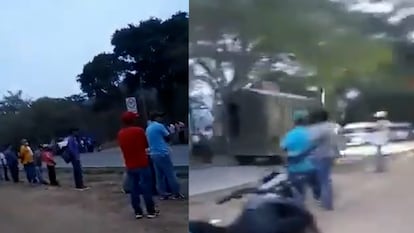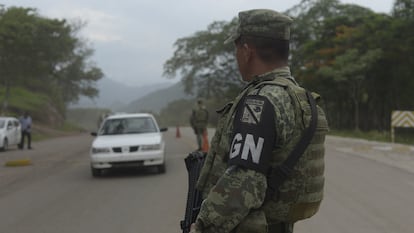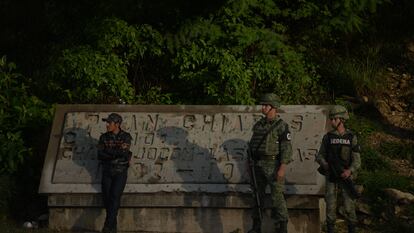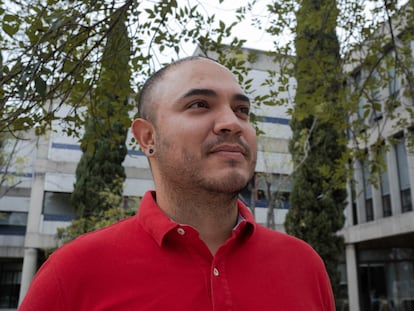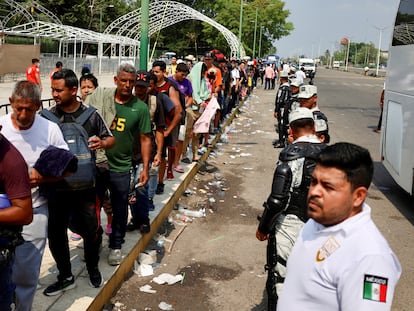Shootings and forced recruitment as cartel battles spread on Chiapas-Guatemala border
For two years, a war between criminal groups has terrorized Frontera Comalapa and its farming communities. Residents and NGOs have denounced an upsurge in violence

The war between criminal groups that is terrorizing the population in a strip of land along the border between the Mexican state of Chiapas and Guatemala is intensifying. In recent days, hundreds of residents have been forced to leave their homes on ejidos (government-managed communal farmland) in the municipality of Frontera Comalapa, north of Tapachula, due to confrontations between the battling factions. The Fray Bartolomé de las Casas Human Rights Center (Frayba) has also reported that the cartels are forcing young people from these communities to join their ranks, under threat of death.
In videos recorded by residents of the communities in the municipality, the effects of the spate of violence are evident. In one, dozens of people can be seen walking quickly, apparently fleeing from criminal groups. Another shows pickup trucks equipped with handmade armor-plating, commonly known in the region as “monsters.” Similar trucks have been seen Michoacán and Tamaulipas in recent years and are used by armed bandits to stage raids.
The recent increase in violence on the border comes on top to the conflicts that other areas of Chiapas have been experiencing for years. In San Cristóbal de las Casas, in the region of Los Altos, shootouts are increasingly common. In April, the murder of Jerónimo Ruiz, the head of the Chiapas Traditional Market Tenants’ Association, unleashed a wave of clashes between armed groups and the burning of houses and cars in the city, one of southern Mexico’s most popular tourist destinations.
The conflict on the border has been ongoing for over two years. Local media report that the warring groups are local factions of the Jalisco New Generation Cartel and the Sinaloa Cartel. The fighting has taken down local leaders, whose only crime has been to try to denounce the situation and force the authorities, particularly the army, to intervene. Those who have dared to speak out have been met with punishment by the gangs.
Last September, residents of the Ejido Sinaloa in Frontera Comalapa reported the disappearance of commissioner Rolando Rodríguez, the community’s highest authority. Local digital media outlet Chiapas Paralelo stated that Rodríguez had been away by criminals after he went to an army barracks in the neighboring town of Comitán to denounce the constant clashes between organized crime groups. At the time, Ejido Sinaloa had been caught in the crossfire between the warring factions.
In April, the cartels also took Roberto Gómez and his children. Like Rodríguez, Gómez was one of Ejido Sinaloa’s leading figures. According to local media, he was kidnapped just a few hundred meters from a military garrison operating in the area. Over the last year and a half, similar cases have been reported in Ejido Sinaloa and other communities in Comalapa. Chiapas Paralelo reports that in this area alone, there have been 59 reports of forced disappearances during this period.
Frayba states that between May 25 and 27, there were blockades, shootings and forced recruitment in the communities of Nueva Independencia, Maravillas, Nuevo Amatenango, Santa Rita la Frontera, and Chamic.
“In the last four days there has been an alarming increase in violence in the municipality,” the organization said in a statement. “Young people from various communities were forcibly recruited by criminal gangs. [Residents] report that at least 3,000 people were displaced from their communities. Some have sought temporary shelter and others have been taking refuge in the mountains or some other safe place for days. We are also informed that many families remain in their homes without being able to leave; they are locked in because of the extreme terror they are experiencing. It has come to this under the mechanics of complicity and abandonment of the Mexican government.”
Sign up for our weekly newsletter to get more English-language news coverage from EL PAÍS USA Edition
Tu suscripción se está usando en otro dispositivo
¿Quieres añadir otro usuario a tu suscripción?
Si continúas leyendo en este dispositivo, no se podrá leer en el otro.
FlechaTu suscripción se está usando en otro dispositivo y solo puedes acceder a EL PAÍS desde un dispositivo a la vez.
Si quieres compartir tu cuenta, cambia tu suscripción a la modalidad Premium, así podrás añadir otro usuario. Cada uno accederá con su propia cuenta de email, lo que os permitirá personalizar vuestra experiencia en EL PAÍS.
¿Tienes una suscripción de empresa? Accede aquí para contratar más cuentas.
En el caso de no saber quién está usando tu cuenta, te recomendamos cambiar tu contraseña aquí.
Si decides continuar compartiendo tu cuenta, este mensaje se mostrará en tu dispositivo y en el de la otra persona que está usando tu cuenta de forma indefinida, afectando a tu experiencia de lectura. Puedes consultar aquí los términos y condiciones de la suscripción digital.
More information
Archived In
Últimas noticias
The relentless struggle between factions deepens the Sinaloa war: bodies in coolers and a surge in homicides
‘Doctor Death’, the journalist who has witnessed 105 executions in Florida
Being trans or gay in a migrant detention center: ‘They call me faggot, queer, bitch’
The metaverse, four years later: Is it finished or just at a standstill?
Most viewed
- The low-cost creative revolution: How technology is making art accessible to everyone
- Christian Louboutin: ‘Young people don’t want to be like their parents. And if their parents wear sneakers, they’re going to look for something else’
- All the effects of gentrification in one corner of Mexico’s Colonia Roma
- Liset Menéndez de la Prida, neuroscientist: ‘It’s not normal to constantly seek pleasure; it’s important to be bored, to be calm’
- Christmas loses its festive spirit: ICE fears cast shadow over religious celebrations

